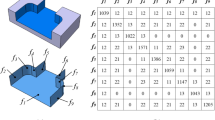Abstract
To discover the knowledge from the machining process planning, it is important to obtain the geometric change of machining feature firstly. This paper proposed a methodology to acquire and describe the change process of machining feature. First, the concept of global machining datum is presented to construct the attributed adjacency graph for faces on the process model. The datum attribute of the vertex correspondent to the face is the unique identifier of correspondent face in the process model sequence. The datum attribute of the vertex, corresponding to the model face, is used to discern the correspondent faces in adjacent process model sequence. Second, the new faces, extinct faces, and maintained faces in adjacent procedure are classified by detecting the parameter changes. Third, with the help of the change types and interrelation of the faces, an algorithm is presented for geometric changes recognition of machining feature. As a result, the change process of a machining feature is discerned as a sequence of machining status. At last, the evolution of machining feature recognition method is verified with an example of machining process planning.
Similar content being viewed by others
References
Joshi S, Chang TC (1988) Graph-based heuristics for recognition of machined features from a 3D solid model. Comput Aided Des 20:58–66
Yuen CF, Venuvinod PK (1999) Geometric feature recognition: coping with the complexity and infinite variety of features. Int J Comput Integr Manuf 12:439–452
Yuen CF, Wong SY, Venuvinod PK (2003) Development of a generic computer-aided process planning support system. J Mater Process Technol 139:394–401
Stefano PD, Bianconi F, Angelo LD (2004) An approach for feature semantics recognition in geometric models. Comput Aided Des 36:993–1009
Verma AK, Rajotia S (2004) Feature vector: a graph-based feature recognition methodology. Int J Prod Res 16:3219–3234
Huang Z, Yip-Hoi D (2002) High-level feature recognition using feature relationship graphs. Comput Aided Des 34:561–582
Woo Y, Sakurai H (2002) Recognition of maximal feature by volume decomposition. Comput Aided Des 34:195–207
Kim YS, Wilde DJ (1992) A convergent convex decomposition of polyhedral objects. ASME J Mech Des 114:468–476
Kim YS, Wang E (2002) Recognition of machining features for cast then machined parts. Comput Aided Des 34(1):71–87
Kim BC, Mun D (2014) Feature-based simplification of boundary representation models using sequential iterative volume decomposition. Comput Graph 38:97–107
Marefat MM, Kashyap RL (1990) Geometric reasoning for recognition of three dimensional object features. IEEE Trans Pattern Anal Mach Intell 12:949–965
Vandenbrande JH, Requicha AAG (1993) Spatial reasoning for the automatic recognition of machinable features in solid models. IEEE Trans Pattern Anal Mach Intell 15:1269–1285
Ma LJ, Huang ZD, Wu QS (2009) Extracting common design patterns from a set of solid models. Comput Aided Des 41:952–970
Regli W C (1995) Geometric algorithm for recognition of features from solid models. Thesis (PhD). Maryland University, USA.
Ozturk N, Ozturk F (2001) Neural network-based nonstandard feature recognition to integrate CAD and CAM. Comput Ind 45:123–135
Chakraborty S, Basu A (2006) Retrieval of machining information from feature patterns using artificial neural networks. Int J Adv Manuf Technol 27:781–787
Sunil VB, Pande SS (2009) Automatic recognition of machining features using artificial neural networks. Int J Adv Manuf Technol 41:932–947
Rahmani K, Arezoo B (2007) A hybrid hint-based and graph-based framework for recognition of interacting milling features. Comput Ind 58:304–312
Verma AK, Rajotia S (2009) Hybrid machining feature recognition system. Int J Manuf Res 4:343–361
Hao YT, Ma JY (2006) A knowledge-based auto-reasoning methodology in hole-machining process planning. Comput Ind 57:297–304
Kojima T, Sekiguchi H, Kobayashi H (2000) An expert system of machining operation planning in internet environment. J Mater Process Technol 107:160–166
Halevi G, Wang K (2007) Knowledge based manufacturing system (KBMS). J Intell Manuf 18:467–474
Amaitik SM, Kilic SE (2007) An intelligent process planning system for prismatic parts using STEP features. Int J Adv Manuf Technol 31:978–993
Bo ZW, Hua LZ, Yu ZG (2006) Optimization of process route by genetic algorithms. Int J Prod Res 37:1063–1074
Author information
Authors and Affiliations
Corresponding author
Rights and permissions
About this article
Cite this article
Wan, N., Du, K., Zhao, H. et al. Research on the knowledge recognition and modeling of machining feature geometric evolution. Int J Adv Manuf Technol 79, 491–501 (2015). https://doi.org/10.1007/s00170-015-6814-y
Received:
Accepted:
Published:
Issue Date:
DOI: https://doi.org/10.1007/s00170-015-6814-y



